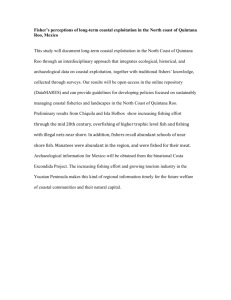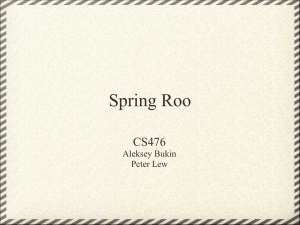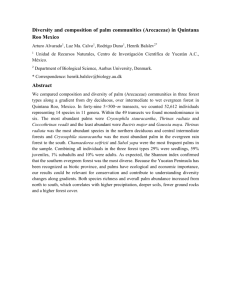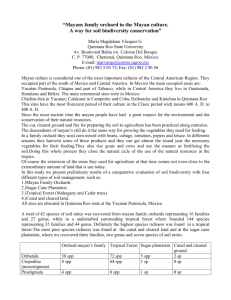A State of Perpetual Fantasy and Leisure
advertisement
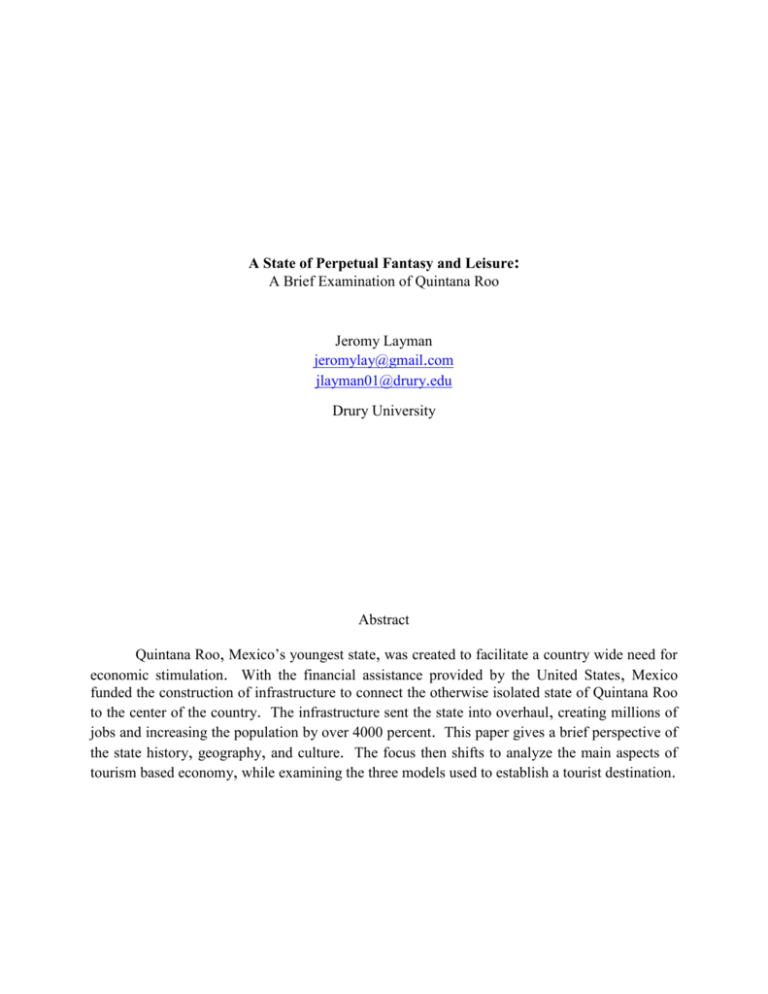
A State of Perpetual Fantasy and Leisure: A Brief Examination of Quintana Roo Jeromy Layman jeromylay@gmail.com jlayman01@drury.edu Drury University Abstract Quintana Roo, Mexico’s youngest state, was created to facilitate a country wide need for economic stimulation. With the financial assistance provided by the United States, Mexico funded the construction of infrastructure to connect the otherwise isolated state of Quintana Roo to the center of the country. The infrastructure sent the state into overhaul, creating millions of jobs and increasing the population by over 4000 percent. This paper gives a brief perspective of the state history, geography, and culture. The focus then shifts to analyze the main aspects of tourism based economy, while examining the three models used to establish a tourist destination. Layman 2 A State of Perpetual Fantasy and Leisure: A Brief Examination of Quintana Roo I. Introduction Over the course of the past century the country of Mexico has experienced economic, political, and cultural shifts. These shifts, which have happened in little less than 60 years, are the direct result of initiatives to help strengthen the Mexican economy. With the aid of the United State government, the Mexican federal government passed legislation, , which funded the construction of infrastructure in the tourist industry sector, in order to open up isolated areas of the country to an entire range of economically stimulating opportunities. These initiatives focused primarily on building creating a desirable tourist destination within targeted Mexican territories, in particular the territory of Quintana Roo. The federal government has created a booming tourism industry, which has been based almost exclusively in the state of Quintana Roo. This paper will give a basic overview of the geography and the geological make-up. Then walk through some of the more historically significant aspects of the tourist industry of Mexico’s youngest state, and then move into contemporary Quintana Roo, with its governmental, cultural, and economic structures. Finally, it will focus on the basics of the Quintana Roo tourism industry. II. Overview of the Geography and Geology of Quintana Roo Quintana Roo is Mexico’s most eastern state, located on the Yucatán Peninsula. Geographically, it is situated south and east of the Mexican state of Yucatán and east of the state of Campeche. Quintana Roo also borders the Caribbean Sea. Being one of the southern most states in Mexico, Quintana Roo borders the Central American country of Belize. Quintana Roo’s capital city Chetumal is located in the most southern tip of the state. The state is approximately 20,000 square miles in land area (Administration 2005-2011: State Plan of Development). A notable feature of Quintana Roo’s landscape is the dense jungle, which dominates the interior area of the state. Discoveries of large Mayan archaeological complexes have been uncovered in the last century due to the development of large portions of this jungle. The uncovering of such sites often adds to the adventure for tourists wishing to have the “Indiana Jones-like” experience. Another dominant geographical feature is the large number of freshwater lagoons and swamps. This is mostly due to the abundant amount of precipitation, which accumulates after a heavy tropical storm. The result of such storms is a complex network of underground rivers, which feed freshwater vents that pour into lagoons and mangrove swamps situated behind any given beach. Often during the course of development of these beachfront areas the swamps are drained and constructed over (Pi-Sunyer 1997: 196-7). Ecological consequences, such as erosion Layman 3 and water pollution in the lagoons, have huge implications on the overall marine and aquatic wildlife. The inland freshwater deposits also impact the offshore barrier reefs; such reefs are a huge draw for tourists who wish to scuba dive or fish, as the freshwater carries necessary nutrients and minerals to the marine life living in the reefs. The geological composition of the state of Quintana Roo is primarily based on the coastal regions. This means that most of the landscape’s composition is sand and stone covering porous calcite bedrock. The interior landscape of the state, has great agricultural potential, but is mostly taken up by the dense jungles. What land that is available is predominantly taken by the tourist industry, which takes precedence over any other industries in Quintana Roo. This most often leads to a lack of soil fertile enough to sustain large amounts of crops (Pi-Sunyer 1997: 197). III. Overview of the History of Quintana Roo Quintana Roo is the youngest state in Mexico, in that it was established as the thirty-first federal state on October 8, 1974. The state’s constitution was ratified on January 12, 1975 (PiSunyer 1997: 187). Prior to 1974 Quintana Roo had been a federal territory and was generally accepted as a part of the neighboring state of Yucatán. Because the interior of the state is comprised mostly of dense jungles and without roads, travel to the coastal regions was almost impossible by conventional means, such as cars, buses, and trains. With that, there was little, if any, outside communication with the territory and so the indigenous people who had sought refuge during the Spanish conquest set up villages. These villages were autonomous and had no consolidated central government until mass tourism was introduced in the early 1970s, with the construction of some of the first highways linking the greater part of Mexico to the isolated area (Oxford 2000: 585-6). After seeing the success of transforming the city of Acapulco into a tourist hotspot, the first National Tourism Congress of 1953 decided to transform the eastern coastline of the Yucatán Peninsula, in particular the village of Cancún, into a major vacationer’s destination. According to census data collected in the 1950s the approximate population of Quintana Roo was 26,967 people (Pi-Sunyer 1997: 195). After the construction of major infrastructure, central Mexico was connected to the eastern peninsula. This opened up and entirely new job market, and brought construction workers and general labors, which bolstered the population. With a steady population growth the state presently has an approximate population of 1.13 million citizens, which is a 4090 percent increase in little less than sixty years (Administration 2005-2011: Population). The increase in population is mainly due to the newfound accessibility of the late 1960s and early 1970s, as well as the prospect of new service-based jobs. These jobs were created when tourist hotspots such as Cancún and Cozumel began to develop. Extravagant vacations created need for laborers to maintain the fantasy, and so the tourism industry created nearly two million jobs in a matter of a few decades. A large migrant population moved from the states of Yucatán and Veracruz seeking highly sought after jobs. One segment of the general population Layman 4 that was overlooked was the indigenous Mayan peoples who, by the 1980s, had become the minority in Quintana Roo, and who remain the largest indigenous group in Mesoamerica (PiSunyer 1997: 188). However, unlike the emigrants from other states, the Mayans did not have any sort of access to standardized education and jobs. This trend continues on into contemporary Quintana Roo, as the Mayan population is continually marginalized in favor of foreign markets and peoples to fulfill the needs of the nearly sixty-year-old industry (Canak 1998: 95). IV. Overview of Contemporary Quintana Roo Like the United States and Canada, Mexico is a federalist system. This means that government power is split between a central or federal government and sub-national governments. Quintana Roo, which is one of the thirty-one state governments, has nine municipalities. Municipalities, which had been introduced during the Spanish conquest and then were officially sanctioned in the Mexican constitution of 1917, are used to divide a Mexican state into nearly autonomous sub-state governments. Each municipality is charged with administrating all of their own public works projects (Oxford 2000: 20). This system is beneficial for the divided and isolated state of Quintana Roo. The capital city, Chetumal, is isolated and removed from the rest of the state. Therefore, this seclusion from the rest of the country and the capital makes the sub-state municipalities an integral part of the general practices of the state. The three basic branches of government are observed: the state legislature, executive branch headed by a governor, and a state court system. The state government answers to the federal government based in Mexico City. Relative to other states, the Quintana Roo state government’s general concern is preserving peace to facilitate the enormous task of maintaining a massive tourism industry, which dominates statewide policy. The tourism industry in Quintana Roo has almost become a self-governing entity apart from the government. The highly competitive industry creates a situation where the state government must cater to the needs of vacationers rather than to the needs of the domestic people. Being a touristic destination, the state has very few scandals that have managed to be well publicized. This lack of publicity comes from the overarching need to remain a desirable destination to outside tourists. One of the largest publicized scandals in Quintana Roo’s history was a case in which former-Governor Mario Villanueva was allegedly authorizing safe passage for drug traffickers from Colombia (Mexican Political Biographies 1995: 952). This included allowing drugs to be trafficked through Quintana Roo into the United States, using the relatively laxer customs checkpoints in the larger touristy cities. (Ward 1999: 677) V. Overview of Tourism in Quintana Roo The Mexican National Tourism Congress of 1953, funded almost entirely by the United States, in coordination with the Mexican president, Miguel Alemán, decided to capitalize on the Layman 5 potential of the territory of Quintana Roo as a major base for Mexican tourism. The initiative’s main intent was to draw in vacationers and with that the large amounts of revenue that accompany booming tourism economies. The territory was a short flight from Florida or any other eastern city in the United States and therefore considered a prime destination and attraction. As of the late 1990s the tourism industry in Quintana Roo contributes nearly three percent of Mexico’s gross domestic product (Pi-Sunyer 1997: 191-2). Quintana Roo’s largest city, Cancún, has a population of nearly 600,000 people and lies in the northern area of the state, essentially at the northern tip of the Yucatán Peninsula (Bernhardson 1998: 909). Cancún also is the largest tourist destination in the country of Mexico, attracting more than two million visitors each year. Today, the city “has become an architectural fantasy city with its grandiose hotels and full range of distractions and attractions vying for tourists’ attention and money” (Pi-Sunyer 1997: 187). However, when the city was originally targeted for development in the early 1960s it was a village of 600 indigenous people, stemming from the ancient Mayan culture. After highways connected the village with the greater part of Mexico, people migrated in from other states for jobs. This allowed for more construction, and with the addition of an airport nearby in the late 1970s, Cancún became a destination hotspot, bringing in more investment and more construction, which in turn caused the population to increase. This caused a self-perpetuating cycle where further development meant more widespread appeal, making Cancún a more popular destination, and in need of further development. (Pi-Sunyer 1997: 190). The self-perpetuating Cancún model, which is seen as a great success, has been used not only in other areas of Mexico, but abroad as well. A prime example of a domestic use of the Cancún model is the village and resort complex of Akumal. Before the development of Akumal as a new exclusive tourist destination, the village of Akumal housed approximately four hundred indigenous peoples, who lived just outside of where the development would take place. According to Pi-Sunyer the village could be compared in construction to the shantytowns of the United State’s Great Depression. Peoples’ homes were constructed out of mostly natural materials such as scraps of wood, masonry, and cinderblocks. The environment was cramped and desolate, and common services, such as electricity, garbage and sewage removal were not provided. Accessibility to potable water was nonexistent. The development of a resort sprung up relatively quickly in the early 1960s. In contrast to the desolate environment of the village, the resort complex was spacious, well maintained, faced the beach, and featured the basic amenities mentioned before. After the resort complex was fully developed, the small village was used to house the service workers for the resort. In 1994, the condominium owners, hotel management, as well as guests began to complain to the local government that the original village was an eyesore for the area and needed to be removed (Pi-Sunyer 1997: 199-200). Complaints claimed that the small village’s waste runoff was a legitimate threat to the small mangrove lagoon. This runoff directly affected the offshore reefs that attracted thousands of scuba divers. By the end of the year half of the small village was razed. In 1996, assisted by a heavy tropical storm which destroyed the integrity of Layman 6 most buildings in the small service village, the government ordered that all buildings in the village be evacuated. There was a minor effort on the government’s part to find supplemental housing for displaced residents; however, the effort was short-lived. There was legal justification for the final demolition of the village because the villagers, who were mostly native Mayan people, did not have titles to their properties, and therefore they were essentially squatters. Thus, the government was well within its rights to legally evict the people living in the service community of Akumal. In 1997 the resort presented a proposal to extend the resort and create further recreational development by draining the mangrove lagoon that had been previously threatened by the villagers (Pi-Sunyer 1997: 199-200). Another model used in creating tourist attractions is the model used in Cobá. The small village in Quintana Roo is adjacent to the largest ancient Mayan ruin complex in Mesoamerica, which, in turn, creates a popular tourist destination. However, the village is not the typical resort oriented attraction that one would generally picture when thinking of Mexican tourism . This form of tourism is called archaeological tourism and basically uses pre-existing sites of historical relevance to attract visitors. The village of Cobá consists of a population of nine-hundred service workers, and their families, who work to maintain the archeological site. The village was created entirely for this purpose, around fifty years ago, in order to house the workers who maintain. The resort hotel hosts nearly 60,000 foreign visitors that visit the archeological site each year (Pi-Sunyer 1997: 201-2). The final model of tourism that Quintana Roo uses is ecotourism, which merely means that the ecosystem and environment are the tourist attraction. This model is used in the village of Punta Laguna, an interior village, which is considered extremely underdeveloped. Tourists arrive at the village to have an “authentic” exotic experience. The focal point of the Punta Laguna experience is to hire a young villager to guide tourists through the forest and showcase wildlife and the like. This “authentic” experience allows villagers to sell craft items and knickknacks for profit. However, out of all of the models described, this model is the least profitable, and often the most culturally dangerous (Pi-Sunyer 1997: 202). VI. General Analysis of Tourism Based Economy There are many advantages to turning to an economy primarily based on the tourism sector, and there also are many severe disadvantages. The components of analysis vary on a case-by-case basis. Some of the major advantages have been previously discussed. They can include an almost overnight boom in revenue. Also, with minor investments into anything from hotels, restaurants, memorabilia production and distribution, or any other number of things, there can be large monetary returns. The disadvantages, which are most times overlooked, can cause major problems in the social fabric of the given place, as a dependence on foreign investment takes localized economic control out of domestic hands and places it abroad. This section will discuss some of the components briefly. Layman 7 Tourism has extremely visible advantages, which make it an appealing option for underdeveloped nations. As was with the case for Mexico, in the early 1950s, the United States took an interest in funding the development of a vacation hotspot abroad . After funding a few infrastructure projects, the territory of Quintana Roo, which until that time was completely isolated, was connected to the rest of Mexico. This can be taken as an advantage. Quintana Roo quickly began to see major developments in infrastructure and technological advancement, as there is a certain amount of carry over from resort complexes. Many scholars argue that this development played heavily into the already established socioeconomic norms of Mexico in general and marginalized the Mayan population already living in the area. However, it must be taken into account that development is voluntary, and that it begins with the peoples cooperation (Friedman 2004: 407). Tourism is an industry that must maintain a very complex relationship with the host government, in part because it is up to the government to maintain transportation infrastructure, but also because it is the government that purchases and maintains advertising abroad (Oxford 2000: 659). This relationship becomes strained if people’s concerns are not met, because generally speaking, tourists do not want to vacation in a place where there is civil unrest or poor public image. So, in a way tourism creates better transparency between the people and the government. One of the major pit falls of tourism, however, is that it creates a system where competition with similar international destinations takes virtually all policy making ability out of the realm of control of the host state, and places it indirectly with the target demographic consumers. In the case of Quintana Roo’s connection with its tourist, makes the state highly dependent on the United States. The United States, which already outsources labor and services to the country of Mexico is also outsourcing something else: “What is being outsourced in Quintana Roo (and Mexico as a whole) is a particular kind of commodity: fantasy and leisure” (Pi-Sunyer 1997: 208). Vacationers arrive at places such as Cancún and Cobá to escape their normal everyday lives. To maintain an illusion of pristine perfection, there literally has to be a system to maintain this. Marginalized groups, such as the working class and the indigenous Mayan population, are underrepresented in government and in the workforce. However, because they are satisfied with the prospect of jobs created by the industry, they stay silent. This is even when the statistics do not work in their favor: seven out of every ten Mexicans, approximately nine million people, live on less than US$300 a month. Because the industry eliminates a lot of local agriculture, when citizens near tourist sites buy food, the money is not injected into the regional economy but rather it stimulates the areas where the food was grown. Resort complexes are considered by academics to be islands of the developed world in Third World environments. “Today, income distribution in Mexico is so skewed that the top ten percent of the population accounts for 39.5 percent of the national income – leaving the bottom twenty percent to manage a share of 4.1 percent” (Pi-Sunyer 1997: 194). This creates situations where money generated in the tourist environments does not circulate in the immediate region. The physicality of these statistics can be seen from basic observations: resort towns such as Cozumel and Cancún have a Layman 8 façade that goes barely two blocks inland. More and more, cruise lines will sell expensive day trips where they take vacationers out of the city, shoppers to the highly controlled environment of an outdoor bazaar, or party-goers to a private beach party, all to maintain the illusions that have come to be associated with Mexican tourism. There is a need to bridge the gap between the resort complexes, which have endless resources through their own self-perpetuation, and the regions of which they are a part. Even though there are economic gains to be made through the tourism industry as well as many jobs created, there are also benefits to utilizing the skill sets and expertise of the indigenous and domestic population. VII. Conclusion In summary, this paper has covered a wide variety of information, from the establishment of the state of Quintana Roo as a direct result of a demand for a tourist hotspot , to a brief synopsis of statewide governmental functions. Finally the paper focuses on an analysis of Quintana Roo’s greatest and most influential entity: tourism. Any sort of basic understanding of the basic state of Quintana Roo would have to be based in the study of tourism. The state of Quintana Roo would not exist today if not for the government intervention of both Mexico and the United States and their seeing the merit and potential in establishing and developing a desirable and fantasy ridden tourist attraction. While there are arguments on both sides as to the advantages and disadvantages of using the tourism industry as a basic economic foundation, it seems that state is in relatively good shape. Layman 9 Bibliography AP Datastream (2009, September 12). Mexican ex-officials to be tried for drug ties. AP DataStream. Retrieved October 13, 2009, from http://campus.westlaw.com/ Agence France Presse English Wire (2009, May 12). Tourist cancellations in Mexico closes 25 hotels: officials. Agence France Presse English Wire. Retrieved October 23, 2009, from http://campus.westlaw.com/ BNamericas.com (2009, July 15). Federal govt, Quintana Roo begin beach remediation program. BNamericas.com. Retrieved October 23, 2009, from http://campus.westlaw.com/ Bernhardson, W., & Brosnahan, T. et al. (1998). Mexico. Hawthorn, Australia: Lonely Planet Publications. Camp, R. A. (2006). Politics in Mexico: The Democratic Consolidation (5 ed.). New York: Oxford University Press, USA. Canak, W., & Swanson, L. (1997). Modern Mexico: A Volume in the Comparative Societies Series (1 ed.). New York City: McGraw-Hill Humanities/Social Sciences/Languages. DPA International Services (2009, April 30). Mexico's tourist sector shudders over flu cancellations. Deutsche Presse-Agentur. Retrieved October 23, 2009, from http://campus.westlaw.com/ EFE (2009, September 24). 10 Die in drug-related violence in Mexico. EFE News Services. Retrieved September 24, 2009, from the Campus Research database. EFE (2007, March 1). Divers find world's longest underwater cave in Mexico. EFE Ingles. Retrieved October 23, 2009, from http://campus.westlaw.com/ Friedman, T. L. (2007). The World Is Flat: A Brief History of the Twenty-first Century. New York, NY: Picador. (Original work published 2002) Government Portal of the State of Quintana Roo. (n.d.). Portal del Gobierno del Estado de Quintana Roo. Retrieved November 30, 2009, from http://www.qroo.gob.mx/en/ Indo-Asian News Service (2009, September 16). Luxury Cancun hotel offers guests opportunity to help Mayans. Indo-Asian News Service. Retrieved October 15, 2009, from http://campus.westlaw.com/ Mexico. (2009, November 11). CIA World Factbook. Retrieved November 30, 2009, from https://www.cia.gov/library/publications/the-world-factbook/geos/mx.html Meyer, M. C., & Beezley, W. H. (2000). The Oxford History of Mexico. New York: Oxford University Press, USA. Morris, S. D. (2009). Political Corruption in Mexico: The Impact of Democratization. Colorado: Lynne Rienner Pub. NewsBank (2009, September 4). 17 Mexicans die in drug-fueled violence in separate attack, gunmen pursue and kill security official in president's home state. The Star-Ledger, pp. 6. Retrieved October 23, 2009, from the Campus Research database. Pi-Sunyer, O., & Thomas, R. B. (1997). Tourism, Environmentalism, and Cultural Survival in Quintana Roo. Life and Death Matters: Human Rights and the Environment at the End of Layman 10 the Millennium (pp. 187-212). Walnut Creek, CA: AltaMira Press. Reuters News (2009, August 18). Drug violence hits Mexican resort in Cozumel. Reuters News. Retrieved October 23, 2009, from http://campus.westlaw.com/ South American Business Information (2009, October 6). Mexico: Quintana Roo exports to EU certified honey. El Financiero. Retrieved October 23, 2009, from http://campus.westlaw.com/ Stiglitz, J. E. (2007). Making Globalization Work. New York: W. W. Norton. Ward, P. M., & Rodriguez, V. E. (1999). New Federalism, Intra-Governmental Relations and Co-Governance in Mexico. Journal of Latin American Studies, 31(3), 673-710. Retrieved October 25, 2009, from the JSTOR database. World News Connection (2008, January 24). Highlights: Mexican Government Security Initiatives 24 Jan 08. World News Connection. Retrieved October 23, 2009, from http://campus.westlaw.com/ World News Connection (2009, September 7). Highlights: Mexico Southeastern Crime/Narcotics/Security Issues 07 Sep 09. World News Connection, pp. N. Retrieved October 23, 2009, from the Campus Research database.
